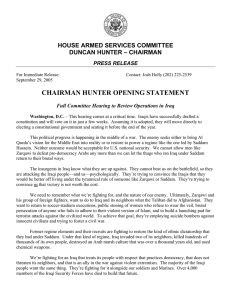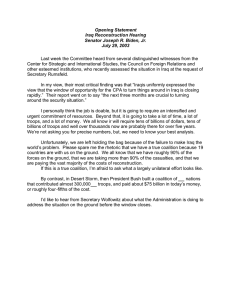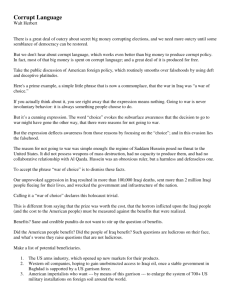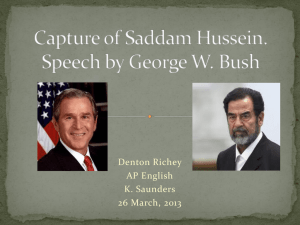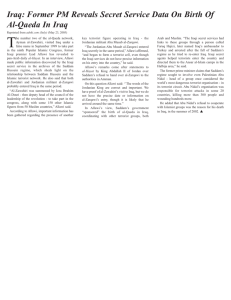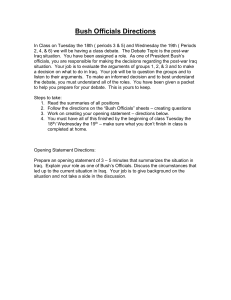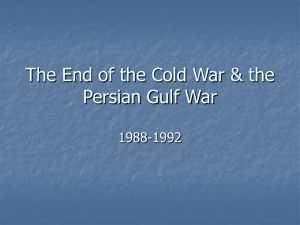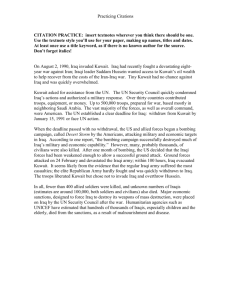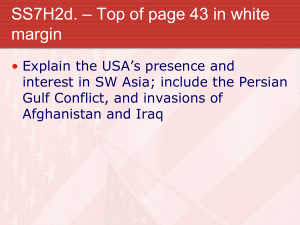Iraq war timeline
advertisement
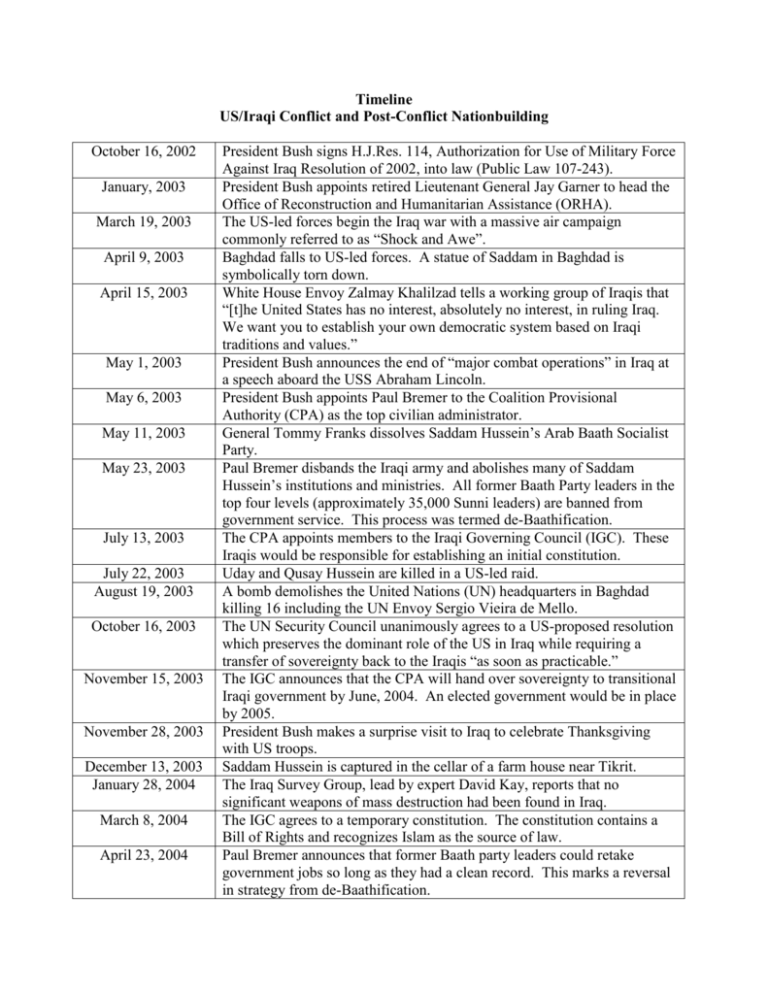
Timeline US/Iraqi Conflict and Post-Conflict Nationbuilding October 16, 2002 January, 2003 March 19, 2003 April 9, 2003 April 15, 2003 May 1, 2003 May 6, 2003 May 11, 2003 May 23, 2003 July 13, 2003 July 22, 2003 August 19, 2003 October 16, 2003 November 15, 2003 November 28, 2003 December 13, 2003 January 28, 2004 March 8, 2004 April 23, 2004 President Bush signs H.J.Res. 114, Authorization for Use of Military Force Against Iraq Resolution of 2002, into law (Public Law 107-243). President Bush appoints retired Lieutenant General Jay Garner to head the Office of Reconstruction and Humanitarian Assistance (ORHA). The US-led forces begin the Iraq war with a massive air campaign commonly referred to as “Shock and Awe”. Baghdad falls to US-led forces. A statue of Saddam in Baghdad is symbolically torn down. White House Envoy Zalmay Khalilzad tells a working group of Iraqis that “[t]he United States has no interest, absolutely no interest, in ruling Iraq. We want you to establish your own democratic system based on Iraqi traditions and values.” President Bush announces the end of “major combat operations” in Iraq at a speech aboard the USS Abraham Lincoln. President Bush appoints Paul Bremer to the Coalition Provisional Authority (CPA) as the top civilian administrator. General Tommy Franks dissolves Saddam Hussein’s Arab Baath Socialist Party. Paul Bremer disbands the Iraqi army and abolishes many of Saddam Hussein’s institutions and ministries. All former Baath Party leaders in the top four levels (approximately 35,000 Sunni leaders) are banned from government service. This process was termed de-Baathification. The CPA appoints members to the Iraqi Governing Council (IGC). These Iraqis would be responsible for establishing an initial constitution. Uday and Qusay Hussein are killed in a US-led raid. A bomb demolishes the United Nations (UN) headquarters in Baghdad killing 16 including the UN Envoy Sergio Vieira de Mello. The UN Security Council unanimously agrees to a US-proposed resolution which preserves the dominant role of the US in Iraq while requiring a transfer of sovereignty back to the Iraqis “as soon as practicable.” The IGC announces that the CPA will hand over sovereignty to transitional Iraqi government by June, 2004. An elected government would be in place by 2005. President Bush makes a surprise visit to Iraq to celebrate Thanksgiving with US troops. Saddam Hussein is captured in the cellar of a farm house near Tikrit. The Iraq Survey Group, lead by expert David Kay, reports that no significant weapons of mass destruction had been found in Iraq. The IGC agrees to a temporary constitution. The constitution contains a Bill of Rights and recognizes Islam as the source of law. Paul Bremer announces that former Baath party leaders could retake government jobs so long as they had a clean record. This marks a reversal in strategy from de-Baathification. April 28, 2004 April 30, 2004 May 28, 2004 May 30, 2004 June 8, 2004 June 28, 2004 August 18, 2004 November 2, 2004 November 15, 2004 January 30, 2005 April 7, 2005 August 28, 2005 October 15, 2005 October 19, 2005 November 30, 2005 December 15, 2005 April 21, 2006 June 8, 2006 Pictures of prisoner abuse from US held Abu Ghraib prison are released by the media. US troops pull out of Falluja after heightened violence. The IGC appoints Iyad Allawi as the interim Prime Minister of Iraq. Allawi was scheduled to take office by the end of June 2004. Allawi announces his choices for cabinet members. The IGC dissolves itself. The UN Security Council unanimously endorses the US plan to transfer power by June 30, 2004. Paul Bremer and the US-lead coalition transfer sovereignty back to Iraq. Allawi is sworn in as the Prime Minister of Iraq. A 100-seat national assembly is appointed to oversee the Allawi administration until general elections occur. President Bush is re-elected to a second term. US-led forces retake Falluja after a week of fierce fighting. Iraqis vote in general elections to elect a transitional Iraqi Parliament. This is the first multi-party election in Iraq in over 50 years. The Iraqi Parliament elects Jalal Talabani as the interim President of Iraq. Ibrahim al-Jaafari is chosen to replace Allawi as Prime Minister. A draft of a permanent Iraqi constitution is agreed to by the Kurdish and Shia leaders, however the Sunni leaders refuse to agree to the draft. Iraqis vote in a referendum on the new proposed Iraqi constitution. The Constitution establishes an Islamic, federal democracy. Saddam Hussein goes on trial for war crimes in Baghdad. The Bush administration releases National Strategy for Victory in Iraq to outline broad strategy and provide an update on the remaining challenges. This document reinforces the Bush administration’s determination to establish a democracy in Iraq and refusal to establish timetables for withdrawal. Iraqis vote for members of the full-term government. The United Iraqi Alliance party, lead by the Shia, wins 128 out of 275 seats failing to secure an outright majority. The Democratic Patriotic Alliance of Kurdistan secured 53 seats and the Iraqi Accord Front, a Sunni party, won 44 seats. The remaining 50 seats were won by various independent parties, including the Iraqi National List, party of former Prime Minister Allawi. Jawad al-Maliki, a Shiite is chosen to replace Ibrahim al-Jaafari as Prime Minister. Abu Musab al-Zarqawi, the leader of al-Qaeda in Iraq, as a result of a targeted U.S. air raid.
